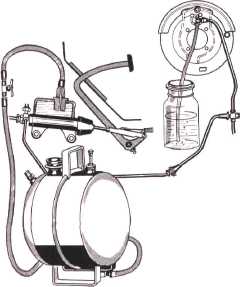|
1949 Delco Brakes Service Manual (Courtesy of Pat Gizz) |
|||
|
DELCO BRAKE SERVICE MANUAL |
|||
|
|
|||
|
CAUTION: When using the filler
jar method operate the brake pedal slowly, otherwise air may be drawn
into the system. It will be found necessary to depress the brake
pedal approximately 10 times to bleed each wheel
cylinder. |
bled; tighten bleeder valve;
remove bleeder hose;
always replace bleeder
screw.
CAUTION: In some cases, when
using a pressure
tank, air bubbles form in the
tank. This difficulty can be avoided if the following suggestions are
carried out: (1) Do not shake or agitate the pressure tank after air
pressure has been added or is being added. (2) Allow pressure tank to
stand in one position as much as possible, and bring air hose over to tank
when adding head of air. (3) Make certain the valves on the pressure tank
lines are not defective
allowing air to be sucked in when fluid passes through the lines.
(4) Pressure tank should be kept at least 1/3 full of fluid to
avoid air bubbles forming. (5) If pressure tank is full of air bubbles,
release air pressure and these bubbles will increase in size and be forced
to top of fluid, and escape.
Fluid drawn out in the
bleeding operation should not
be used again.
INSTRUCTIONS FOR FLUSHING
Safe, efficient, dependable
operation of hydraulic brake controls depends greatly upon the system
being kept clean and free from foreign
matters, gum, etc., and upon the fluids having and retaining the
proper characteristics. Past experiences with hydraulic brakes have shown
definitely that dirt does get into the system, causing leaks and,
eventually, brake failure. Many brake fluids become thick, resulting
in inefficient brake operation; other fluids will break down under hard
usage, causing eventual loss of braking action.
So that the hydraulic brake
system will operate at its best at all times, the brake system should be
cleaned, flushed, and refilled every 10,000 miles. This will remove all
dirt accumulation in the System and insure proper level of brake
fluid. Declene, a specially compounded fluid, is recommended for flushing
the brake system. Declene is available in quart cans—enough to service one
car. (See Figure 12.) It is red in color to help distinguish it from brake
fluid and as a means of indicating when it is coming through the line
clean.
Two methods of flushing are
commonly used, namely—washing the master cylinder with Declene fed from a
gravity filler jar and pumped through the system by working the brake
pedal slowly, or forcing the Declene into the master cylinder
reser- |
||
 |
|||
|
Fig. 11B—Bleeding Delco Hydraulic Brake
System
When using filler jar, the master
cylinder should always be re-filled after bleeding each wheel
cylinder so that no air gets into the system. When bleeding operation is completed, be certain that
the master cylinder reservoir
is filled to the proper level.
(B) If the pressure tank method
is used, remove filler cap assembly on master cylinder and make sure that
the master cylinder reservoir is filled with fluid; make certain pressure
tank hose is filled with fluid, then
attach to master cylinder. Prepare wheel cylinder for bleeding as
outlined under filler jar method; apply pressure to hydraulic brake
system not to exceed 35 pounds. Too much pressure may blow out the
expansion plug in the master cylinder fluid reservoir. When using the
pressure tank, it is not necessary to pump the brake pedal to bleed the
system. When bubbles of air stop coming from bleeder hose, that particular cylinder and
line are |
|||
|
|
|||
|
9 |
|||
|
|
|||